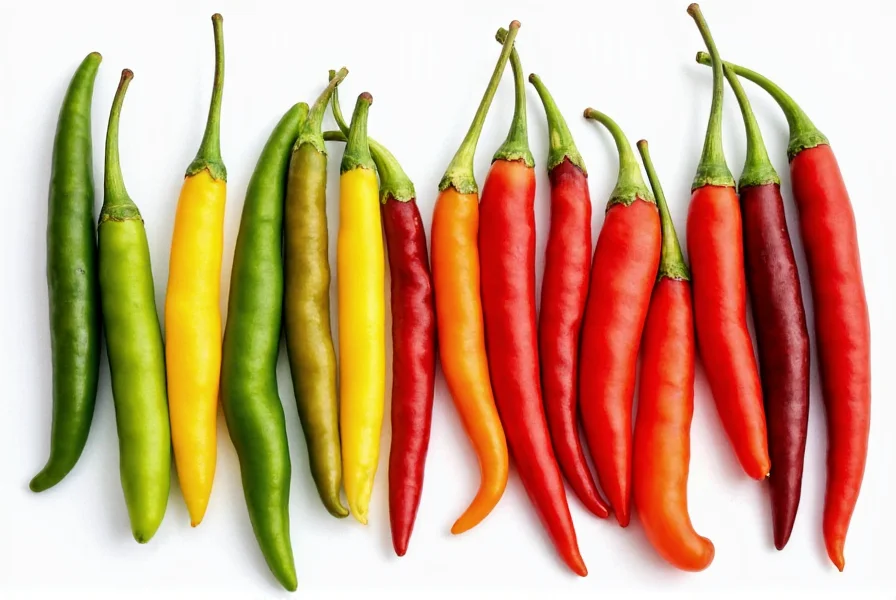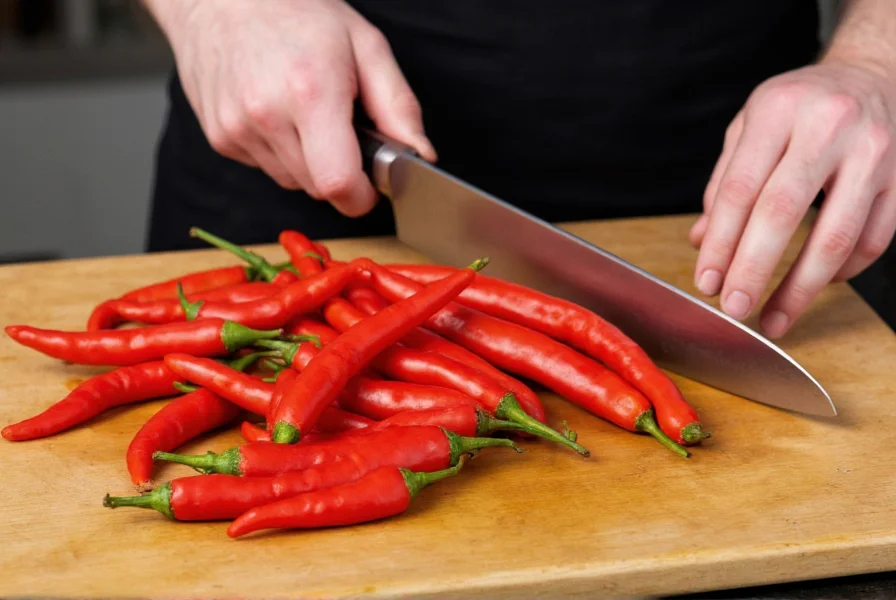Chili peppers, scientifically classified under the Capsicum genus, represent one of the world's most versatile and widely consumed spice ingredients. Despite the common misspelling "chili peper," these vibrant fruits have shaped culinary traditions across continents for thousands of years. Understanding their varieties, heat levels, and applications helps both home cooks and gardening enthusiasts make informed choices.
Historical Journey of Chili Peppers
Originating in modern-day Mexico and Central America over 6,000 years ago, chili peppers spread globally after Christopher Columbus's voyages. Contrary to popular belief, "peppers" weren't related to black pepper (Piper nigrum)—European explorers coined the term due to their similar pungency. By the 16th century, chili peppers had integrated into Asian, African, and European cuisines, transforming local food cultures permanently.
Understanding Chili Pepper Varieties
With hundreds of cultivated varieties, chili peppers fall into five primary species:
| Species | Common Examples | Heat Range (Scoville) |
|---|---|---|
| Capsicum annuum | Bell peppers, Jalapeños, Serranos | 0-50,000 SHU |
| Capsicum frutescens | Tabasco, Malagueta | 30,000-100,000 SHU |
| Capsicum chinense | Habanero, Scotch Bonnet, Carolina Reaper | 100,000-2,200,000+ SHU |
| Capsicum baccatum | Aji varieties | 30,000-50,000 SHU |
| Capsicum pubescens | Rocoto | 5,000-50,000 SHU |
Each species offers unique flavor profiles beyond heat, from the fruity notes of habaneros to the earthy tones of chipotle peppers. When selecting types of chili peppers for cooking, consider both heat level and flavor compatibility with your dish.

Measuring Heat: The Scoville Scale Explained
In 1912, pharmacist Wilbur Scoville developed the Scoville Organoleptic Test, which measures capsaicin concentration. Modern high-performance liquid chromatography (HPLC) provides more precise measurements, but the Scoville Heat Unit (SHU) remains the standard reference.
Understanding chili pepper heat levels helps prevent culinary disasters. For context:
- Bell peppers: 0 SHU (no heat)
- Jalapeño: 2,500-8,000 SHU
- Serrano: 10,000-23,000 SHU
- Habanero: 100,000-350,000 SHU
- Carolina Reaper: 1,400,000-2,200,000 SHU
Heat perception varies by individual and can intensify when seeds and white membranes (where capsaicin concentrates) remain in recipes.
Nutritional Benefits and Health Considerations
Chili peppers deliver impressive nutritional value beyond their heat. A single jalapeño provides:
- Over 100% of the daily recommended vitamin C
- Significant vitamin B6 and potassium
- Antioxidants like capsaicin and carotenoids
- Negligible calories (about 4 per pepper)
Research suggests health benefits of chili peppers include:
- Metabolism enhancement through thermogenesis
- Pain relief properties when applied topically
- Potential cardiovascular benefits from improved circulation
- Anti-inflammatory effects
However, excessive consumption may cause digestive discomfort for sensitive individuals. Those with gastrointestinal conditions should consult healthcare providers about appropriate intake levels.
Culinary Applications Across Global Cuisines
From Mexican salsas to Thai curries, cooking with chili peppers demonstrates remarkable versatility. Different preparation methods affect heat perception:
- Fresh peppers: Immediate, bright heat (ideal for salsas and salads)
- Dried peppers: Concentrated, smoky flavors (used in rubs and stews)
- Fermented peppers: Complex, tangy heat (found in hot sauces)
- Roasted peppers: Sweetened, mellowed heat (perfect for dips and sauces)
When substituting mild chili pepper varieties for hotter options, remember that heat intensity varies even within the same variety based on growing conditions and ripeness.

Growing Chili Peppers at Home
Whether in containers or garden beds, growing chili peppers at home offers fresh harvests with proper care:
- Start seeds indoors 8-10 weeks before last frost
- Provide 6-8 hours of direct sunlight daily
- Maintain consistent moisture (avoid waterlogging)
- Harvest when peppers reach full color for maximum flavor
Container gardening works well for most varieties, with dwarf cultivars like Thai hot peppers thriving in pots as small as 12 inches in diameter. Remember that stress factors like inconsistent watering can increase capsaicin production, making peppers hotter than expected.
Safety and Handling Tips
When working with hot chili pepper varieties, follow these safety precautions:
- Wear gloves to prevent skin irritation
- Avoid touching face or eyes during preparation
- Use dairy products (milk, yogurt) to counteract excessive heat
- Store dried peppers in airtight containers away from light
Never use water to alleviate burning sensations from capsaicin—it spreads the oil rather than neutralizing it. The compound's oil-based nature means fat-containing substances like olive oil or milk provide more effective relief.
Common Questions About Chili Peppers
What's the difference between chili peppers and bell peppers?
Bell peppers are a specific variety of Capsicum annuum that lack capsaicin, the compound responsible for heat in chili peppers. While all bell peppers are chili peppers botanically, not all chili peppers are hot. Bell peppers come in multiple colors (green, red, yellow, orange) representing different ripeness stages, with sweeter flavors developing as they mature.
How can I reduce the heat of a dish that's too spicy?
To reduce excessive heat in a dish, add dairy products like yogurt or sour cream, which contain casein that binds to capsaicin. Acidic ingredients like lime juice or vinegar can also help balance heat perception. Adding more non-spicy ingredients to dilute the dish works effectively, as does incorporating starchy components like rice or beans. Never use water, as it spreads rather than neutralizes the capsaicin oil.
Are there health risks associated with eating very hot chili peppers?
While most people safely consume hot chili peppers, extremely spicy varieties can cause temporary gastrointestinal distress, including stomach pain and diarrhea. In rare cases, excessive consumption of super-hot peppers has been linked to esophageal injury. Individuals with gastrointestinal conditions like ulcers or IBS should exercise caution. The body's natural response to extreme heat (sweating, flushing) is generally harmless but can be uncomfortable.
Why do chili peppers make my nose run and eyes water?
Capsaicin triggers the trigeminal nerve, which responds to irritants. This neurological reaction causes increased mucus production (runny nose) and tear production as your body attempts to flush out the perceived irritant. The effect is temporary and varies by individual sensitivity. Consuming spicy food in well-ventilated areas can help minimize these reactions.
Can I grow chili peppers indoors year-round?
Yes, chili peppers can thrive indoors with proper conditions. Choose compact varieties like Thai hot or ornamental peppers. Provide 12-16 hours of full-spectrum light daily, maintain temperatures between 70-85°F (21-29°C), and ensure good air circulation. Use well-draining potting mix and containers with drainage holes. Indoor plants may need manual pollination by gently shaking flowers or using a small brush to transfer pollen.










 浙公网安备
33010002000092号
浙公网安备
33010002000092号 浙B2-20120091-4
浙B2-20120091-4